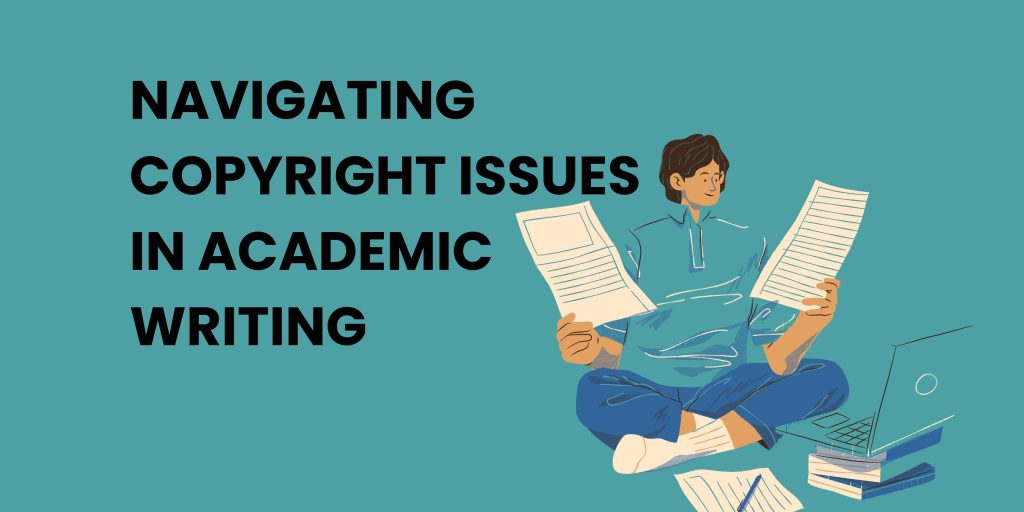Copyright is a legal framework that grants authors and creators exclusive rights to their original works. When engaging in academic writing, it is essential to navigate copyright issues to ensure that your use of others’ work complies with the law and respects intellectual property rights. In this blog post, we will explore the intricacies of copyright in academic writing, discuss fair use and permissions, and provide practical tips for navigating copyright issues. Additionally, we will highlight a real-world example to illustrate the importance of understanding and adhering to copyright laws.
Understanding Copyright:
Copyright is a form of intellectual property protection that grants authors and creators exclusive rights over their original works. It covers a wide range of creative works, including text, images, music, videos, and software. In academic writing, copyright applies to various materials, such as scholarly articles, books, images, and multimedia content.
Fair Use and Permissions:
Fair use is a legal doctrine that allows limited use of copyrighted material without permission from the copyright owner under certain circumstances. The concept of fair use varies across jurisdictions, but it generally considers factors such as the purpose and character of the use, the nature of the copyrighted work, the amount and substantiality of the portion used, and the effect of the use on the market for the original work.
Determining fair use can be complex and requires a careful analysis of these factors. However, there are common scenarios in academic writing where fair use may apply, such as:
- Quoting for Commentary and Criticism: Using short excerpts from copyrighted works to support your analysis, commentary, or criticism is often considered fair use. However, the use should be proportionate and serve a transformative purpose.
- Educational and Research Purposes: In the context of academic writing, using copyrighted materials for educational or research purposes can be considered fair use. This may include including images, diagrams, or excerpts from scholarly works to support your arguments or provide context.
- Parody and Satire: Creating parodies or satirical works that incorporate copyrighted material for the purpose of humor, commentary, or social critique may fall under fair use. However, the transformative nature of the work and the extent of the use are important considerations.
Navigating Copyright Issues:
- Understand Copyright Laws: Familiarize yourself with the copyright laws applicable in your jurisdiction. Different countries have varying laws and exceptions regarding fair use. Stay updated on any changes or updates to copyright legislation to ensure compliance with the law.
- Seek Permissions: If your use of copyrighted material goes beyond fair use, it is advisable to seek permission from the copyright owner. This is particularly important for substantial portions of copyrighted works or for commercial purposes. Contact the copyright owner and request permission to use their work, specifying the purpose, extent, and duration of the use.
- Use Open Access Resources: Open access resources, such as articles published under Creative Commons licenses or in open access journals, provide more flexibility in terms of reuse and citation. When possible, prioritize using open access resources to avoid copyright issues and promote open scholarship.
- Proper Attribution: Proper attribution is crucial when using others’ copyrighted material. Provide clear and accurate citations for all sources you incorporate in your work, following the appropriate citation style guidelines. This includes citing both direct quotes and paraphrased information.
- Obtain Licenses: In certain cases, it may be necessary to obtain licenses for copyrighted material, such as images or multimedia content. There are stock photo websites, music libraries, and other platforms that provide licenses for various types of content. Ensure that you have the appropriate licenses for the material you use.
Real-World Example:
A notable example of copyright infringement occurred in the case of the “Blurred Lines” song by Robin Thicke and Pharrell Williams. The song was found to have infringed upon the copyright of Marvin Gaye’s “Got to Give It Up.” This case highlighted the importance of understanding copyright laws and the potential consequences of unauthorized use of copyrighted material, even in the realm of music.
Conclusion:
Navigating copyright issues in academic writing is essential for upholding ethical standards, respecting intellectual property rights, and avoiding legal consequences. Understanding fair use and obtaining permissions when necessary are key aspects of navigating copyright in academic writing. Familiarize yourself with copyright laws, seek permissions when needed, use open access resources, provide proper attribution, and obtain licenses when required. By adhering to copyright laws, you can ensure that your academic writing is ethically sound and respects the rights of creators.
